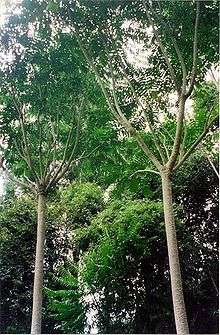Polyscias murrayi
Polyscias murrayi, known as the pencil cedar, is a very common rainforest tree of eastern Australia.
| Polyscias murrayi | |
|---|---|
 | |
| Pencil cedar at Berrico Trig, Barrington Tops, Australia | |
| Scientific classification | |
| Kingdom: | Plantae |
| Clade: | Tracheophytes |
| Clade: | Angiosperms |
| Clade: | Eudicots |
| Clade: | Asterids |
| Order: | Apiales |
| Family: | Araliaceae |
| Genus: | Polyscias |
| Species: | P. murrayi |
| Binomial name | |
| Polyscias murrayi | |
| Synonyms | |
| |
It occurs as a secondary regeneration species in disturbed rainforest areas, often on hillsides. The tree is identified by cylindrical trunk; abruptly forking into many branches, and supporting an impressive dark canopy.
Other common names include the umbrella tree, white basswood and pencilwood. The range of natural distribution is from the Howe Range, just over the border in the state of Victoria (37° S),[1] up through New South Wales and to Atherton, Queensland (17° S). It also occurs in New Guinea.
Description
This small to medium size tree grows to 25 metres tall with a trunk diameter of 50 cm. It is unbranched at the end of the main trunk, then breaks out into a many branched crown. The cylindrical trunk is mostly smooth, greyish or brown. The base of the tree is not flanged, fluted or buttressed.
Leaves are alternate and pinnate with 8 to 30 leaflets, opposite on the leaf stalk, entire or toothed, ovate lanceolate in shape, 8 to 15 cm long. However, leaves may be much larger on younger trees. Leaf stalks are up to 120 cm long and leaflet stalks 3 to 8 mm long. Between each pair of leaflets on the leaf stalk, a gland may be seen. The midrib is white or paler green, raised under the leaf. Leaf venation is more easily seen on the top of the leaf.
Creamy green flowers form on stalks on umbels in the months of February to March. The fruit is a blue drupe, usually with two lobes, sometimes three. Fruit matures from April to June. Germination from fresh seed is slow.
The fruit is eaten by a variety of birds, including the brown cuckoo dove, Lewin's honeyeater, rose crowned fruit dove, satin bowerbird and superb fruit dove.
Uses
Polyscias murrayi is useful to bush regenerators as a nursery tree, which provides shade for longer lived young trees underneath. It is also an attractive ornamental tree.
References
- Notes
- "Croajingolong National Park" (PDF). Parks Victoria. Archived from the original (PDF) on 23 July 2008. Retrieved 12 July 2008.
- Bibliography
- Floyd, A. G. (1989). Rainforest Trees of Mainland South-eastern Australia (1st ed.). Port Melbourne: Elsevier Australia - Inkata Imprint, copyright Forestry Commission of New South Wales (published 1 December 1989). p. 74. ISBN 0-909605-57-2. Retrieved 12 July 2009. (other publication details, included in citation)
- Henwood M.J. & R.O. Makinson (1993). "Polyscias murrayi – New South Wales Flora Online". PlantNET - The Plant Information Network System. 2.0. Sydney, Australia: The Royal Botanic Gardens and Domain Trust. Retrieved 14 November 2012.CS1 maint: uses authors parameter (link)
- Hyland, B. P. M.; Whiffin, T.; Zich, F. A.; et al. (December 2010). "Factsheet – Polyscias murrayi". Australian Tropical Rainforest Plants (6.1, online version RFK 6.1 ed.). Cairns, Australia: Commonwealth Scientific and Industrial Research Organisation (CSIRO), through its Division of Plant Industry; the Centre for Australian National Biodiversity Research; the Australian Tropical Herbarium, James Cook University. Retrieved 15 March 2013.